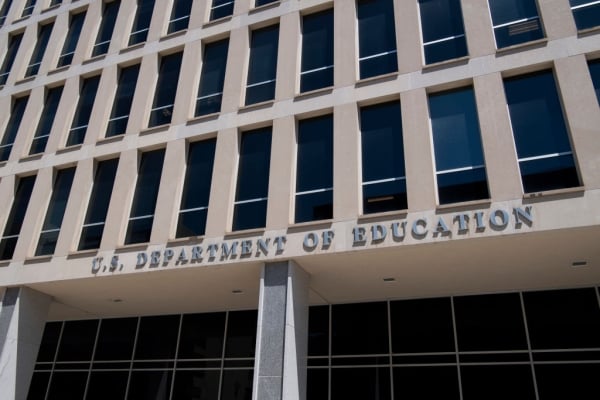Chatter about the potential executive order to dismantle the agency began Friday.
Caroline Brehman/CQ-Roll Call Inc./Getty Images
The Trump administration is preparing an executive order to dismantle the Education Department, though the specifics are still in the works, two news outlets reported Monday.
The Wall Street Journal first reported that the order could “shut down all functions of the agency that aren’t written explicitly into statute or move certain functions to other departments,” citing anonymous sources familiar with the matter. Likewise, The Washington Post reported that the order wouldn’t directly abolish the agency but instead “directs the agency to begin to diminish itself,” citing three people who were briefed on the order.
Other sources familiar with talks about the order told Inside Higher Ed as early as Friday that the order would at least direct the education Secretary to come up with a plan to break up the department. No executive order has officially been signed, but a White House official told the Post that one is in the works for later this month and “will fulfill Trump’s campaign pledge to defund the department.”
Sources told the Journal and the Post that the White House should hold off on the executive order until Linda McMahon, Trump’s nominee to lead the Education Department, has been confirmed. But the Senate has yet to even schedule a committee-level hearing, let alone a confirmation vote.
On Friday, when chatter first started among lawmakers, higher education lobbyists and advocates about the potential for such an order, Inside Higher Ed reached out to the Department of Education but was redirected to the White House. A White House spokesperson then declined to comment on the record.
Only Congress can get rid of the agency, so the executive order would mostly amount to a messaging tactic. But the Trump administration can take other steps to make the agency a shell of itself, from cutting staff to stopping some programs.
Already, the administration has put dozens of Education Department employees on paid leave. And the Post reported that some staffers in the Trump administration’s Department of Governmental Efficiency, which is not a cabinet-level department but an initiative run by billionaire Elon Musk, have access to a “financial aid dataset that contains the personal information for millions of students enrolled in the federal student aid program.”
Aaron Ament, president of Student Defense, a legal advocacy group, sounded the alarm about Trump’s attempt to dismantle the department following the media reports.
“Effectively shutting down the Department of Education through executive action or mass firings is a short-sighted, deeply unpopular recipe for chaos and confusion,” Ament said in a statement. “It will disrupt the lives of students across the country. And trying to do it without Congress is clearly illegal and unconstitutional. We’re already exploring options to stop this unconstitutional overreach.”
Republicans have targeted the Education Department for destruction since it was created, but so far, no plan to meaningfully reduce the agency’s footprint has been successful. Few experts think the Trump administration will be successful this time around in dismantling the Education Department. (During his first term, Trump proposed merging the Departments of Education and Labor.)
But higher education policy experts acknowledge that momentum is building toward the idea, particularly after the Biden administration forgave billions in federal student loans, worked to expand rights for transgender students and mishandled the rollout of the 2024–25 Free Application for Federal Student Aid. The most recent version of the FAFSA is back on track, though former department officials caution that disruptions to the department could undo that progress.
Attempting to break up the Education Department raises more questions for higher education administrators and advocates who are already scrambling to understand the implications of President Trump’s first two weeks in office. The moves—from targeting funding for diversity, equity and inclusion programs to a pause on research grants—have caused confusion on campuses.
College and university stakeholders worry that abolishing the Education Department could be catastrophic for institutions and students. State higher education officials, university administrators, nonprofit advocacy groups and students depend on the Education Department to oversee federal student aid, manage the student loan portfolio, investigate civil rights complaints and allocate billions of dollars in institutional aid, among other operations. More than 4,000 people work for the agency, which has an $80 billion discretionary budget.
Several experts have said that any effort to break up the department would likely leave its programs in place. For example, lawmakers and conservative think tanks have proposed moving the department’s federal student aid programs, including the Pell Grant and management of student loans, to the Treasury Department, while the Office for Civil Rights would move to the Department of Justice.
Critics of the department argue the agency’s existence violates the Constitution because the document doesn’t mention education. They also say that the order is a prime example of federal bloat. Trump says the agency has grown too big and interferes in matters best left to local and state authorities. Instead, he wants to send education back to the states, though he hasn’t explained how he would do that yet.








